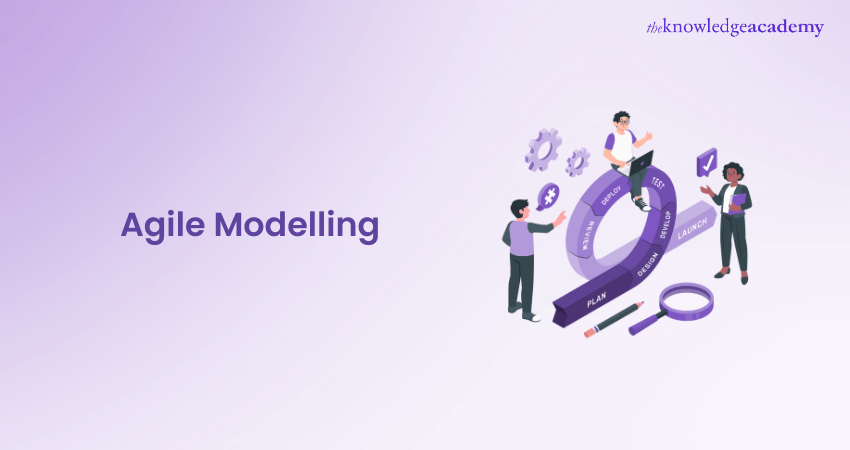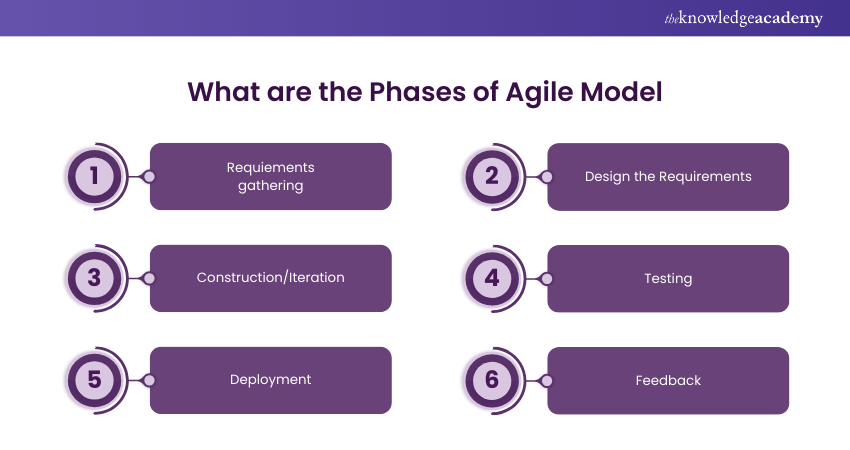We may not have the course you’re looking for. If you enquire or give us a call on +800 312616 and speak to our training experts, we may still be able to help with your training requirements.
We ensure quality, budget-alignment, and timely delivery by our expert instructors.

Agile is a term that means quick or adaptable. A software development methodology based on iterative development is called an "Agile process model." Agile project management techniques divide work into smaller iterations or pieces without directly including long-term planning. The project's requirements and scope are established at the start of the development phase.
Our expanding digital world has an escalating demand for complex and numerous applications. However, there is a conflict between this requirement and the high failure rates in software development. Failure rates for system development frequently exceed 75%.
Developers use Agile modelling to reduce high failure rates and provide high-quality apps for an expanding user base. Today, we'll delve into Agile modelling, its definition, core principles, phases, best practices, advantages and disadvantages, and other helpful information.
Let’s learn more about Agile since it has a lot to offer the development community.
Table of Contents
1) Understanding What is Agile Modeling?
2) Let’s Discuss the Core Principles of Agile Modeling
3) What are the Phases of Agile Model?
4) Agile Modeling – Best Practices
5) When to use the Agile Model?
6) The Advantages and Disadvantages of Agile Model
7) Conclusion
Understanding What is Agile Modeling?
A practice-based methodology for efficient modeling and documentation is called Agile modeling (AM).
Some of its crucial concepts include-
1) Model- A model is an abstraction that represents essential aspects of something or a concept. Diagrams are one type of model, whereas text descriptions and executable models can also be used (working code or equivalent). Within the Agile community, maps and roadmaps are other names for models.
2) Agile Model- Agile models can be as basic as sticky notes on a wall, whiteboard doodles, digitally captured diagrams created using a drawing tool, or intricate models created with a model-based software engineering (MBSE) tool.
3) Modeling- Modeling is the act of building a model. Mapping is another name for modeling.
4) Agile Modeling- Agile Modeling is modeling that is carried out in a cooperative and progressive way.
5) Document- Documents serve as lasting representations of objects or ideas. While all models are documents, not all documents.
6) Agile Document- An Agile document can be as basic as a list of bullet points, a comprehensive text document, a set of executable tests, or one or more Agile models.
The modelling enhances current Agile approaches like the Rational Unified Process (RUP) or extreme programming (XP). Agile modelling aids software developers in designing a process that meets their needs for development while remaining adaptable enough to handle unforeseen circumstances.
Join our Agile Project Management Foundation and Practitioner Course to learn more about the Agile Methodology!
Let’s Discuss the Core Principles of Agile Modeling
The modeling adheres to 11 fundamental principles-
1) Model with a Purpose-
Inquire as to why and for whom you are creating the models.
2) Adopt Simplicity-
Keep the models as plain and straightforward as you can, and always go with the best answer that is also the simplest.
3) Accept Change-
The more you learn about a project, the more probable it is that it will evolve. Accept change and have the courage to readjust and rebuild rather than resisting it.
4) Your second objective is to support the next effort-
After you leave, your successors may need to enhance or improve your project. Give them enough models and documentation to accelerate any potential adjustments or upgrades.
5) Continual Change-
A model rarely succeeds on the first attempt. Models change as the project expands and progresses. By making small adjustments to the models as necessary, you can reduce the impact of change.
6) Maximize Investment from Stakeholders -
The team must put out its best effort to create software that satisfies the needs of the stakeholder. Keep in mind that the software's primary goal is to optimise the client's return.
7) Remember the Existence of Multiple Models-
Choose the modeling options that best suit the current situation from the many that are offered. The transmission of software can be done in a variety of ways as well.
8) Produce Quality Work-
Nobody wants hastily completed work. The reason the developer doesn't like it is that they know that it's not something they can be proud of. Teams that check the work later are not fond of it because it is difficult to understand and requires more time to rectify. Finally, the substandard work won't be appreciated by the end users because it probably won't perform properly or won't live up to their expectations.
9) Provide Prompt Feedback-
The model's understanding loop is closed when it gets timely feedback. Model a tiny section, present it for review to the right stakeholders, and then repeat the process.
10) Make Software Functionality your Primary Goal-
Building excellent software for your client is the final goal; models are merely a way to achieve it. Make sure your Agile model, and documentation directly advance the objective of your software development project.
11) Travel Light-
Traveling light is another way of emphasising that you have only the necessary documentation for the models you are creating. If there is little documentation, the development team may become disoriented; contrarily, if there is excessive documentation, the team may forget that the main objective is to build software and the appropriate models, not to write documentation!
Join our Agile Project Management Foundation and Practitioner Course to learn more about the Agile Methodology!
What are the Phases of Agile Model?

In the overall process model, the Agile model divides jobs into smaller iterations, each of which lasts for a brief period (one to four weeks). There are various variants of the model and its phases-
1) Requirements Gathering-
The requirements for the project are specified here. In this phase, business potential is explained, and the project's time and effort requirements are planned. After quantifying this data, you may assess the project's technical and financial viability.
2) Design the Requirements-
Once the project's parameters have been determined, define the requirements in collaboration with the stakeholders.
3) Construction/Iteration-
The real work starts after the team specifies and designs the requirements. Teams from the product, design, and development departments begin working on linked projects with the goal of launching a dynamic product or service.
4) Testing-
The quality assurance (QA) team reviews and assesses the functionality of the product while keeping an eye out for bugs and other defects.
5) Deployment-
The product is introduced by the team into a working setting.
6) Feedback-
After the product is made available, the team reviews customer feedback and addresses any problems that may have occurred.
Ready to nail your next Agile interview? Explore our comprehensive guide to Agile Interview Questions now!
Agile Modeling – Best Practices
Some of the standard best practises are mentioned below-
1) Active Stakeholder Engagement-
Stakeholders must provide information, make timely product decisions, and be as actively involved in the development process as possible, using inclusive tools and techniques.
2) Architectural Planning-
To find a workable technical plan for developing a solution, the team must first perform some basic, high-level architectural modeling.
3) Iteration Agile Modeling-
You must perform some modeling as part of your planning exercises at the beginning of each cycle.
4) Just Barely Good Enough (JBGE) Artifacts-
An Agile model or document must be sufficient for the current circumstance only.
5) Model Storming-
It may be necessary to model storms just in time (JIT) for a short while during an iteration. This time commitment enables the team to investigate the details of a demand or resolve a design issue.
When to use the Agile Model?
You can use Agile Model-
1) When regular alterations are necessary
2) When a highly skilled and knowledgeable workforce is accessible
3) When a client is prepared, a software team will meet with them at any time
4) When a project is small in scope
Want to become an Agile Project Manager? Register for our our AgilePM Foundation Certification course today!
The Advantages and Disadvantages of Agile Model
The pros and cons of Agile Model are as follows-
Advantages-
1) The Agile Modeling presents both advantages and disadvantages.
2) Encourages teams and clients to communicate effectively.
3) Agile model increases project flexibility and makes it simple to handle any abrupt adjustments.
4) Agile model decreases the overall development time.
5) Agile model increases client satisfaction by delivering a functional product quickly and consistently.
6) Delivers working software on a regular basis, in weeks in contrast to months.
Disadvantages-
1) Due to the lack of emphasis placed on documentation, confusion across teams may emerge in an Agile model. Phase changes can be problematic as a result of this ambiguity.
2) It might be challenging to estimate the amount of work required to begin the development life cycle of larger software deliveries.
3) The project will fail if all stakeholders are not on the same page.
4) Agile model is not for beginners. Agile decisions call for individuals with experience as well as strong development and programming skills.
Ready to lead and drive success? Enroll in our Change Management Certification program to gain the skills and credentials you need.
Conclusion
Software development success depends on Agile modeling, and the sector needs Agile leaders. If Agile piques your interest, The Knowledge Academy's Agile Training Courses can help you understand its intricacies. So, hurry! Check out our training courses today to jumpstart a new career!
Enhance your project management skills with the Agile Project Management Methodology PDF—download it now!
Upcoming Project Management Resources Batches & Dates
Date
 Agile Project Management Foundation & Practitioner (AgilePM®)
Agile Project Management Foundation & Practitioner (AgilePM®)
Mon 3rd Mar 2025
Mon 10th Mar 2025
Mon 17th Mar 2025
Sat 22nd Mar 2025, Sun 23rd Mar 2025
Mon 24th Mar 2025
Mon 31st Mar 2025
Mon 7th Apr 2025
Mon 14th Apr 2025
Tue 22nd Apr 2025
Mon 28th Apr 2025
Tue 6th May 2025
Mon 12th May 2025
Sat 17th May 2025, Sun 18th May 2025
Mon 19th May 2025
Tue 27th May 2025
Mon 2nd Jun 2025
Mon 9th Jun 2025
Mon 16th Jun 2025
Mon 23rd Jun 2025
Mon 30th Jun 2025
Mon 7th Jul 2025
Mon 14th Jul 2025
Sat 19th Jul 2025, Sun 20th Jul 2025
Mon 21st Jul 2025
Mon 28th Jul 2025
Mon 4th Aug 2025
Mon 11th Aug 2025
Mon 18th Aug 2025
Mon 25th Aug 2025
Mon 1st Sep 2025
Mon 8th Sep 2025
Mon 15th Sep 2025
Sat 20th Sep 2025, Sun 21st Sep 2025
Mon 22nd Sep 2025
Mon 29th Sep 2025
Mon 6th Oct 2025
Mon 13th Oct 2025
Mon 20th Oct 2025
Mon 27th Oct 2025
Mon 3rd Nov 2025
Mon 10th Nov 2025
Sat 15th Nov 2025, Sun 16th Nov 2025
Mon 17th Nov 2025
Mon 24th Nov 2025
Mon 1st Dec 2025
Mon 8th Dec 2025
Mon 15th Dec 2025






 Top Rated Course
Top Rated Course



 If you wish to make any changes to your course, please
If you wish to make any changes to your course, please


